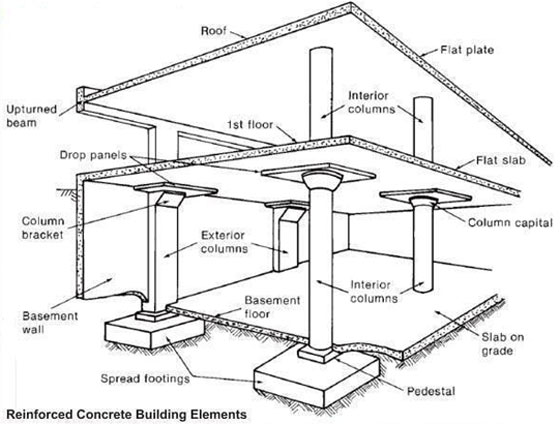Reinforced Concrete Building Elements
Home » Quantity-take-off Sheets

1st Floor: It contains 1 flooring height on top of the ground.
Basement Floor: It is situated at the base of the building. It is also known as cellar. It is constructed either entirely or partly underneath the ground floor. A basement is identical to the supplementary above-ground floor concerning a house or other building. However, the utilization of basements mainly vary on some particular components which are associated with the environmental area like climate, soil, seismic activity, building technology, and real estate economics.
The concrete floor in most basements does not belong to the foundation structure except the basement walls. With the increase of warm air, basements are usually chiller as compared to the rest of the house. Because of greater relative humidity in summer, the basements become damp.
Basement Wall: The wall encircling the basement floor is termed as the basement wall. The basement walls are the structural part of the base. The basement walls refer to shear walls useful for combating with lateral laods. Besides, these walls are considered as extremely non-absorbent and water tight.
Column Bracket: Column Bracket is over-hanged from the column and it is applied for hanging or affixing lamps, bulbs or other accessories to it.
Column Capital: Column capital denotes an architectural component that builds the uppermost member of a column or a pilaster. It intercedes connecting the column and the load pushes down on it, expand the area of the column's supporting surface.
Drop Panels: Drop panels are useful for solidifying the slab around the column in flat slabs to get rid of punching shear. Because flat slabs do not contain stirrups, shear is defended through solidifying the slab around the column so that the concrete in shear gets expanded. Drop panels are used so that the conflicts does not occur with the electromechanical works of the structure.
Exterior Columns: The exterior columns mainly provide support to the primary structure of the building. Exterior Columns are generally used in frame structures. It the load of the building and defends against environmental factors like wind, rain, and other physical factors.
Flat Plate: Slabs are directly attached to columns. Flat plate system is very much popular among engineers. The system is used to shrink the height of the building as well as minimize the cost of materials as it facilitates more adaptable spatial planning caused by non-existence of beams. The engineers faces problem with this system due to collapse of flat plate under punching shear. Owing to the comparatively small floor loading and the tight column spacing, flat plate is mostly recognized. To support massive loading and bigger column spacing, it is suggested to use column capitals. Waffle slabs are generally used to handle larger spans and decrease the self-weight used.
Read More: aboutcivil.org/reinforced-concrete-building-elements.html

|